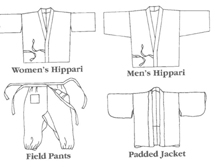Make Your Own Japanese ClothesContentsBook contains:
BASIC ELEMENTS
THE GARMENTS
Plus care, storage, metric conversion charts and index. There is an
extensive list of supply sources for fabrics, dyes, Japanese sewing
tools and notions, and a list of recommended books for further
reading.
Note: The hanten pattern is used for the traditional judo jacket. The weight and strength of the jacket was originally due to hand-stitched sashiko embroidery, designed to protect the precious hand-woven fabric. Close rows or tight patterns were stitched on the upper portion. Embroidery on the lower half (subject to less strain) was usually limited to a simple diamond pattern for strength without bulk. Nowadays the jacket top may be made of a heavy woven-only cotton. The lower embroidery has survived longer but some manufacturers now emulate it by floating a thread in the weave, others by simply "bubbling" in (as in cotton pique) a diamond pattern. The underlying rationale is not addressed by either of these commercial methods, but can be if you wish to make your own. Gi pants can be adapted from the slacks pattern and karate-style jacket from the hippari top or kimono patterns. (An actual pants pattern with the traditional crotch gusset and hippari top is included in our Japanese Field Clothing pattern. See also our Kimono pattern.) A pattern for tabi (the Japanese split-toe slipper socks) is included in our Hapi/Haori pattern, but you will find additional information on history, fitting, and variations in this book. |
catalog | order form | e-mail | home
www.round-earth.com
